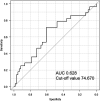Geriatric nutritional risk index as a risk-factor for Clostridioides difficile infection relapse in elderly Japanese patients
- PMID: 36397789
- PMCID: PMC9613364
- DOI: 10.2185/jrm.2022-027
Geriatric nutritional risk index as a risk-factor for Clostridioides difficile infection relapse in elderly Japanese patients
Abstract
Objective: Old age is a risk factor for Clostridioides difficile infection (CDI). As the world's aging population increases, identifying risk factors for CDI in elderly patients is a matter of urgency. This study examined the relationship between CDI relapse and nutritional status using the geriatric nutritional risk index (GNRI). Patients and Methods: Between January 2016 and December 2021, 108 patients were diagnosed with CDI. Of the 108 patients, 19 were excluded because of younger age (<65 years), early death within 14 days of the initial CDI diagnosis, and insufficient data. The patients were divided into low- (<75) and high-GNRI groups (≥75) based on the receiver operating characteristic curve analysis. Variables associated with CDI relapse were also analyzed. Results: The median GNRI scores in all patients and in the low- and high-GNRI groups were 74.9, 68.9, and 83.9, respectively. Of the 89 patients, 28 (31.8%) experienced a CDI relapse. The log-rank test showed a significantly better relapse-free survival (RFS) in the high GNRI group (P=0.002). Univariate analysis revealed that low GNRI (P=0.004), chronic kidney disease (CKD) (P=0.004), and beta-lactamase inhibitor administration before the initial diagnosis of CDI (P=0.025) were significantly correlated with RFS. Multivariate analysis revealed that low GNRI (P=0.008) and CKD (P=0.010) were independent prognostic factors for RFS. Conclusion: Among elderly patients, a low GNRI was strongly associated with CDI relapse. Our study may help clinicians to consider therapeutic strategies for elderly patients with CDI.
Keywords: Clostridioides difficile infection; elderly; geriatric nutritional risk index; nutritional status; relapse.
©2022 The Japanese Association of Rural Medicine.
Conflict of interest statement
The authors declare that they have no competing interests.
Figures



Similar articles
-
Prognostic values of geriatric nutritional risk index (GNRI) and prognostic nutritional index (PNI) in elderly patients with Diffuse Large B-Cell Lymphoma.J Cancer. 2021 Oct 11;12(23):7010-7017. doi: 10.7150/jca.62340. eCollection 2021. J Cancer. 2021. PMID: 34729103 Free PMC article.
-
Impact of geriatric nutritional risk index on outcomes after gastrectomy in elderly patients with gastric cancer: a retrospective multicenter study in Japan.BMC Cancer. 2022 May 12;22(1):540. doi: 10.1186/s12885-022-09638-6. BMC Cancer. 2022. PMID: 35549906 Free PMC article.
-
The Value of Geriatric Nutritional Risk Index in Evaluating Postoperative Complication Risk and Long-Term Prognosis in Elderly Colorectal Cancer Patients.Cancer Manag Res. 2020 Jan 9;12:165-175. doi: 10.2147/CMAR.S234688. eCollection 2020. Cancer Manag Res. 2020. PMID: 32021433 Free PMC article.
-
Preoperative Geriatric Nutritional Risk Index: A predictive and prognostic factor in patients with pathological stage I non-small cell lung cancer.Surg Oncol. 2017 Dec;26(4):483-488. doi: 10.1016/j.suronc.2017.09.006. Epub 2017 Sep 25. Surg Oncol. 2017. PMID: 29113668
-
Prognostic value of geriatric nutritional risk index in elderly patients with heart failure: a meta-analysis.Aging Clin Exp Res. 2021 Jun;33(6):1477-1486. doi: 10.1007/s40520-020-01656-3. Epub 2020 Aug 6. Aging Clin Exp Res. 2021. PMID: 32766928 Review.
Cited by
-
Association between Geriatric Nutritional Risk Index and all-cause mortality in individuals with osteoporotic fractures: a retrospective cohort study.Aging Clin Exp Res. 2025 Mar 11;37(1):77. doi: 10.1007/s40520-025-02978-w. Aging Clin Exp Res. 2025. PMID: 40069532 Free PMC article.

